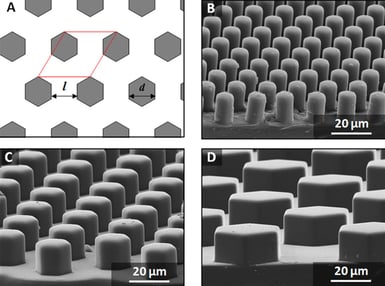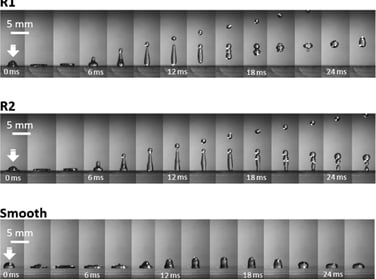The wetting of textured surfaces
One of my main research topics is the investigation of wetting properties on surfaces modified by micro- and nano-scale texturing, chemical patterning, or porosity. My research aims to understand how these surface modifications influence liquid behavior, including droplet morphology and dynamics, contact angle hysteresis, and imbibition processes.
A significant part of my work has focused on textured surfaces, particularly superhydrophobic materials. Since these surfaces strongly repel water, traditional sessile drop methods are not applicable. To characterize wetting in these cases, I have used alternative techniques, such as the Wilhelmy plate method to measure advancing and receding contact angles, and the drop impact/rebound method, which provides insights into the dynamic wetting behavior of non-wettable surfaces [29, 33, D2, 39].
In addition to texturing, I have investigated chemically patterned surfaces, focusing on the stability of condensed water structures. By analyzing how water segments form and persist on surfaces with hydrophilic-hydrophobic contrast, I have contributed to a better understanding of how chemical heterogeneity affects droplet retention and morphology, which is relevant for applications such as fog-harvesting surfaces [24].
My research has also explored wetting in porous media, particularly in porous networks formed by the assembly of beads. I have studied how pore structure influences the imbibition dynamics of water/ethanol microdroplets, revealing how capillary forces govern liquid penetration in model porous systems [23, 28].
Another key aspect of my work has been the development of highly superhydrophobic PDMS surfaces textured using femtosecond laser processing. These surfaces have been studied as functional coatings for bacterial adhesion control, specifically to assess the role of air entrapped air in bacterial attachment [39, 40].



